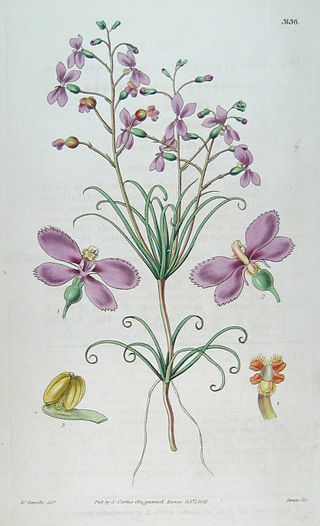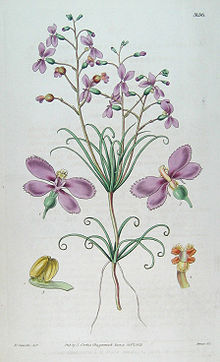
Stylidium is a genus of dicotyledonous plants that belong to the family Stylidiaceae. The genus name Stylidium is derived from the Greek στύλος or stylos, which refers to the distinctive reproductive structure that its flowers possess. Pollination is achieved through the use of the sensitive "trigger", which comprises the male and female reproductive organs fused into a floral column that snaps forward quickly in response to touch, harmlessly covering the insect in pollen. Most of the approximately 300 species are only found in Australia, making it the fifth largest genus in that country. Triggerplants are considered to be protocarnivorous or carnivorous because the glandular trichomes that cover the scape and flower can trap, kill, and digest small insects with protease enzymes produced by the plant. Recent research has raised questions as to the status of protocarnivory within Stylidium.

The family Stylidiaceae is a taxon of dicotyledonous flowering plants. It consists of five genera with over 240 species, most of which are endemic to Australia and New Zealand. Members of Stylidiaceae are typically grass-like herbs or small shrubs and can be perennials or annuals. Most species are free standing or self-supporting, though a few can be climbing or scrambling.
Juliet Ann Wege is an Australian botanist. She graduated in 1992 and gained a PhD at The University of Western Australia in 1999 with a thesis titled "Morphological and anatomical variation within Stylidium (Stylidiaceae): a systematic perspective". As of 2021 she works as a researcher at the Western Australian Herbarium run by Western Australia's Department of Biodiversity, Conservation and Attractions and is managing editor of Nuytsia. Her main area of expertise is in taxonomy and study of the Stylidiaceae family of triggerplants.
Nuytsia is a peer-reviewed scientific journal published by the Western Australian Herbarium. It publishes papers on systematic botany, giving preference to papers related to the flora of Western Australia. Nearly twenty percent of Western Australia's plant taxa have been published in Nuytsia. The journal was established in 1970 and has appeared irregularly since. Kevin Thiele and Juliet Wege have been in the editorial committee.

Oreostylidium is a genus of flowering plants in the family Stylidiaceae with a single species, Oreostylidium subulatum, that is endemic to New Zealand. O. subulatum is a very small plant with small, white flowers. It has a complicated botanical history that has led to a few proposals to move Oreostylidium to the related genus Stylidium. The researchers cite molecular data and suspect that this species is an extreme example of floral paedomorphosis. This would not be an unprecedented move since the single species was initially described as Stylidium subulatum in 1864 and later moved to its own genus by Sven Berggren in 1878. It possesses the same kind of glandular trichomes underneath the flower that make Stylidium species carnivorous plants, but it has not yet been tested for the presence of digestive enzymes.

Donatia is a genus of two cushion plant species in the family Stylidiaceae. The name commemorates Vitaliano Donati, an Italian botanist.

Tolypangium is a subgenus of the genus Stylidium that is characterized by ovoid to longish capsules. This subgenus was part of the earliest taxonomic division among the triggerplants. Stephan Ladislaus Endlicher first split the genus into two subgenera in 1838: Tolypangium with its ovoid capsules and Nitrangium with its linear capsules. Subsequent authors generally followed this classification, which is based almost entirely on the features of the capsule. Recent genetic analysis, combined with an exhaustive morphological comparison, has revealed that the classification defined by Johannes Mildbraed in 1908 is not the most accurate description of how the members of different subgenera and sections are related. As part of the Flora of Australia series, Juliet Wege will be reviewing and updating the taxonomy of the Stylidiaceae.
Repentes is a section in the subgenus Tolypangium. Repentes is a group of creeping triggerplants known as the locket triggerplants, related to subgenus Nitrangium section Appressae. They possess adpressed stem leaves bearing a small basal spur and uni-flowered inflorescences. Because section Repentes morphologically resembles the other creeping triggerplants in section Appressae, Allen Lowrie et al. (1999) proposed all species in this section be moved to section Appressae and Repentes be placed into synonymy. Juliet Wege (2006), however, argued that these species are morphologically distinct from those in section Appressae, citing trichome and column cunabulum structure as distinctions that separate the sections.

Forstera is a genus of small perennial plants in the Stylidiaceae family named in honour of the German naturalists Johann Reinhold Forster and his son, Georg Forster, who had previously described Forstera's sister genus, Phyllachne just five years earlier. It comprises five species that are endemic to New Zealand with the exception of F. bellidifolia, which is endemic to Tasmania. The species in this genus resemble those in a subgenus of the related genus Stylidium called Forsteropsis, but they are more closely related to the genus Phyllachne. Proposals to merge the two genera based on information from cladistic analysis have emerged because of these genera's morphological similarities and evidence that they are paraphyletic.

Forstera bellidifolia, the Tasmanian forstera, is a species in the family Stylidiaceae that is endemic to Tasmania, Australia. It was described by William Jackson Hooker in an 1851 volume of Icones Plantarum. It is notably different from other members of the genus in that it is not native to New Zealand nor does it possess the epigynous nectaries that are present in the other species.

Dual specificity protein phosphatase 15 is an enzyme that in humans is encoded by the DUSP15 gene.

Donatia novae-zelandiae is a species of mat-forming cushion plant, found only in New Zealand and Tasmania. Common names can include New Zealand Cushion or Snow Cushion, however Snow Cushion also refers to Iberis sempervirens. Donatia novae-zelandiae forms dense spirals of thick, leathery leaves, creating a hardy plant that typically exists in alpine and subalpine bioclimatic zones.

Stylidium perplexum is a species of triggerplant that is endemic to south-west Western Australia. It is a tuberous species that has many stems and has been described as "somewhat shrubby" at 15–40 cm tall. The linear leaves can be 2 cm long and are arranged around the stem in a rosette at the stem apices. The 8–19 cm tall scapes bear 6 to 14 flowers that are white with purple accents and corolla lobes that are laterally paired and 4–6 mm long.

Phyllachne is a genus of four cushion plant species in the family Stylidiaceae. Of the four species, two are endemic to New Zealand, while P. colensoi is also native to Tasmania and P. uliginosa is entirely endemic to southern South America and is the only species in the Stylidiaceae native to the Americas. The movement of P. colensoi to colonize Tasmania is a relatively recent move. Molecular studies group P. colensoi, P. clavigera, and P. rubra together in one clade with P. uliginosa in the sister clade. Based on molecular clock data of the rbcL gene, it is estimated that P. uliginosa last shared a common ancestor with the New Zealand clade about 6 million years ago.

Stylidium affine is a species in the genus Stylidium that is endemic to Western Australia.

Phyllachne colensoi, the yellow cushionplant, is a species of cushion plant in the Stylidiaceae family. It is native to both New Zealand and Tasmania, with colonisation of the latter being a somewhat recent dispersal. Phyllachne colensoi is frequently the dominant vegetation in upland bog habitats and is found throughout high mountain areas in New Zealand, but is only recorded from 12 sites in Tasmania in the west and south-west of the island.
Stylidium asymmetricum, the asymmetric triggerplant, is a flowering plant species of the genus Stylidium and is endemic to south-west Western Australia. It is an annual plant from 2 to 16 cm high that grows at the margins of swamps in clay soils. It is only known from two populations in the Northern Jarrah Forest south-west of York and thus it was listed as Priority Two under the Declared Rare and Priority Flora List and more work is necessary to determine the population stability and existing threats, such as feral pigs and off-road vehicles, to the plants. The species epithet asymmetricum refers to the marked asymmetrical corolla arrangement, where the uppermost posterior lobe and the uppermost anterior lobe of the corolla meet at nearly a 90 degree angle, giving the flower a lopsided appearance.
Stylidium exappendiculatum is a species of dicotyledonous plant in the genus Stylidium.
Marco Duretto is a manager and senior research scientist at the Royal Botanic Gardens Sydney in Australia.
Marianthus aquilonaris is a species of flowering plant in the family Pittosporaceae and is endemic to a restricted part of the southwest of Western Australia. It is an erect, multi-stemmed shrub with elliptic to oblong leaves and pale blue to almost white flowers arranged singly in leaf axils.











